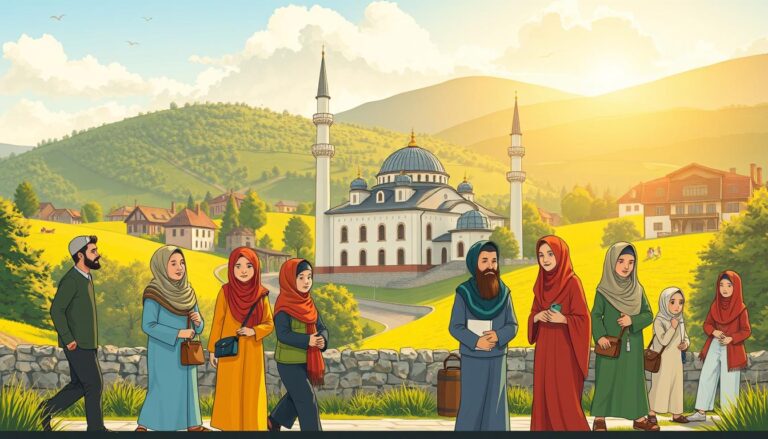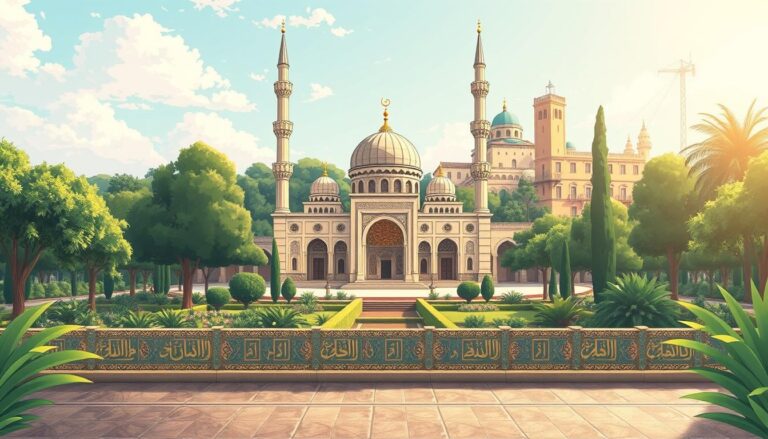Islam in Armenia
Did you know that in Armenia, the percentage of the population that adheres to Islam is less than 1%? This surprising statistic underscores the unique religious landscape of this Caucasian nation, where the vast majority of the population identifies as Christian. However, the history of Islam in Armenia is more complex than these numbers might suggest. Over the centuries, the Armenian Plateau has been influenced by waves of Muslim invasions, settlements, and conversions that have left an indelible mark on the country’s cultural and architectural heritage.
Key Takeaways
- Islam arrived in Armenia during the 7th century Arab invasions, with Muslim Arabs and later Turkic nomads settling in the region.
- Under the Umayyad and Abbasid Caliphates, Armenians experienced political autonomy but were considered second-class citizens.
- The Ottoman Empire’s policies of forced conversion and taxation led to the Islamization of some Armenian populations, especially in western regions.
- Armenia became an integral part of the Shia Islamic world under the Iranian Safavid, Afsharid, Zand, and Qajar dynasties.
- Despite the historical presence of Islam, Armenia today maintains a predominantly Christian identity with a small but culturally significant Muslim minority.
Introduction to Islam in Armenia
Armenia, a predominantly Christian nation, has a long and complex relationship with Islam. While the majority of the population belongs to the Armenian Apostolic Church, the country is home to a small but significant Muslim minority. Understanding the history and presence of Islam in Armenia is crucial to appreciating the country’s diverse religious landscape.
Overview of the Muslim Population in Armenia
According to the latest census data, the Muslim population in Armenia comprises only a small fraction of the total population, estimated at just 0.02% or around 515 individuals. This makes Armenia one of the countries with the smallest Muslim populations in Europe. The majority of these Muslims are Azerbaijanis and Kurds, with the Muslim community primarily concentrated in the capital city of Yerevan.
Historical Background of Islam’s Arrival
The presence of Islam in Armenia can be traced back to the 7th century, when Arab and Kurdish tribes began settling in the region following the initial Arab invasions. The Turkic element from the Seljuk invasions in the 11th and 12th centuries further contributed to the Islamic influence in the area. Over the centuries, the Muslim population in Armenia has fluctuated, with periods of both growth and decline.
Despite the relatively small number of Muslims in the country, Armenia’s Islamic heritage is undeniable. From architectural marvels to cultural traditions, the influence of Islam can still be seen in various aspects of Armenian society, showcasing the unique tapestry of religious diversity that has shaped the nation’s history.
Early Muslim Conquests and Invasions
The Arab invasions of Armenia were a part of the broader Muslim conquests that followed the death of the Islamic prophet Muhammad in 632 CE. The first Arab expedition reached Armenia in 639/640 CE, on the heels of their conquest of the Levant from the Byzantines and the start of the Muslim conquest of Persia.
Arab Raids and Conquests in the 7th Century
The Arabs were led by Iyad ibn Ghanim, who had previously conquered Upper Mesopotamia, and penetrated as far as Bitlis. A second expedition occurred in 642 CE, when the Muslim army advanced and divided into four corps up to northeastern Anatolia, only to be defeated and pushed out of the country. It was not until 645/646 CE that a major campaign to subdue Armenia was undertaken by Mu’awiya, the governor of Syria.
Over the next few decades, the Arab invasions of Armenia continued, with the 7th century Muslim conquests in Armenia gradually establishing an early Islamic presence in Armenia. These early Arab raids and conquests laid the foundations for the eventual spread of Islam in the region.
“Within ten years of Muhammad’s death, Arabs conquered Syria, Palestine, Phoenicia, Mesopotamia, and Egypt.”
The rapid expansion of the Islamic Empire under the Rashidun and Umayyad Caliphates led to the incorporation of Armenia into the growing Muslim dominion. While the country faced periods of resistance and conflict, the 7th century Muslim conquests in Armenia ultimately paved the way for the early Islamic presence in Armenia that would shape the region’s history for centuries to come.
Spread of Islam During Medieval Times
During the medieval period, the Muslim influence in Armenia grew progressively stronger. Following the Byzantine defeat at Manzikert in 1071, waves of Turkic nomads from Central Asia and northern Iran penetrated and settled throughout Armenia and Anatolia. While most ethnic Armenians remained Christian, some Armenians converted to Islam and became influential members of Beylik society.
The spread of Islam in medieval Armenia also had a significant impact on the region’s architecture. Armenian architecture influenced Seljuk architecture, and many Armenian Nakharars (lords) remained autonomous leaders of Armenian society under Muslim Emirs in regions like Erzincan, Tayk, Sassoun, and Van. The Muslim Emirs even intermarried with Armenians, as exemplified by the Shaddadids of Ani who intermarried with Bagratid women.
The Islamic culture in medieval Armenia was further strengthened by the presence of these Turkic nomads and the intermarriage between Armenians and Muslim rulers. This period saw a significant increase in the Muslim population and influence in Armenia, although the majority of the population remained Christian.
Life Under Ottoman Rule
The Armenians faced significant challenges during the centuries-long Ottoman rule. Many were forced to convert to Islam through a process known as Islamization, which was particularly prevalent in certain regions of the Ottoman Empire.
Forced Conversions and Islamization
Throughout Western Armenia, Armenians were compelled to convert to Islam through a variety of methods, including massacres, social pressure, and heavy taxation. This process of Islamization was especially common in regions like Hamshen, Yusufeli, Tortum, İspir, Bayburt, and Erzincan.
In the region of Tortum, a Muslim cleric named Mullah Jaffar was tasked with conducting a census and imposing hefty taxes, leading the Chalcedonian Armenians to convert to Islam, while the Apostolic Armenians largely resisted conversion.
Regions with Significant Islamized Armenian Populations
Similar forced conversions occurred in other parts of the Ottoman Empire, such as the regions of İspir, Yusufeli, Urfa, and Dersim. In these areas, Armenians often converted to Alevi Islam and assimilated with the local Kurdish Zazas population.
“The Ottoman government indicted Young Turk leaders responsible for the Armenian Genocide following World War I, but the post-war government closed military tribunals under pressure from the Nationalists, halting prosecution of criminal offenders.”
The Islamization of Armenians under Ottoman rule had a significant impact on the demographic and cultural landscape of the region, as many communities were transformed and integrated into the Muslim populations of the empire.
Islam in Armenia
Islam has a long and complex history in Armenia, a country where the majority of the population identifies as Armenian Apostolic. According to the 2011 census, around 92% of Armenians practice the Armenian Apostolic faith. However, the Islamic presence in the region dates back centuries, with Muslim communities playing a significant role in the country’s religious and cultural landscape.
The largest Muslim population in Armenia resides in the capital city of Yerevan, comprising Kurds, Iranians, and Middle Eastern nationals. These Muslims primarily follow the Shafi’i branch of Sunni Islam, and there is also a substantial Yazidi community among the Kurds, whose beliefs incorporate elements of Zoroastrianism, Islam, and animism.
The Constitution of Armenia guarantees the freedom of religion, including the right to practice any faith or to be atheist. This has allowed the various religious communities, including Muslims, to coexist and thrive in the country. The Blue Mosque in Yerevan, the only active mosque in Armenia, serves as a hub for the local Muslim population and attracts visitors from Muslim-majority countries.
While the Muslim presence in Armenia is relatively small, the country has not been immune to the regional turmoil that has affected neighboring countries. The ongoing conflicts and humanitarian crises in Syria and Iraq have led to the influx of Armenian refugees, posing social and economic challenges for the small nation. Additionally, the rise of Sunni Islamist movements in Azerbaijan and the proximity of the Islamic State’s former territory have raised concerns about the potential for regional destabilization.
Despite these challenges, Armenia has maintained a relatively stable religious landscape, with the government and the majority population promoting tolerance and coexistence among different faiths. The country’s diverse religious makeup, including its Muslim communities, continues to be an integral part of Armenia’s rich cultural heritage.
Prominent Armenian Muslims
Among the notable Prominent Armenian Muslims who have left an indelible mark on history is Farqad Sabakhi. Sabakhi, who passed away in 729 AD, was a revered Armenian Muslim preacher and a companion of the renowned Sufi figure Hassan Basri. Originally a Christian, Sabakhi later converted to Islam and is considered one of the Tabi’in, the generation that followed the companions of the Prophet Muhammad.
Farqad Sabakhi: A Companion of Hassan Basri
Farqad Sabakhi was renowned for his ascetic lifestyle and deep understanding of the Judeo-Christian scriptures. He is believed to have played a pivotal role in the spiritual development of the famous Sufi figure Karkhi, who went on to make significant contributions to the shaping of Sufism as a spiritual tradition.
“Farqad Sabakhi was a shining example of the rich cultural and religious diversity that has long been a part of Armenia’s history.”
Sabakhi’s legacy as an Armenian Muslim figure serves as a testament to the enduring presence of Islam within the Armenian community, a testament to the nation’s ability to embrace and accommodate diverse religious and cultural influences.
The story of Farqad Sabakhi and other Prominent Armenian Muslims highlights the complex and often overlooked narrative of the Armenian people’s engagement with the Islamic world, a narrative that deserves greater attention and recognition.
Armenian Interaction with Islamic Rulers
Armenia’s relationship with the Caliphate and Beylik states has been a complex and nuanced affair. For around 200 years, Armenia remained under Arab rule, starting from the 7th century CE. During the Umayyad and Abbasid dynasties, the Armenian Christians enjoyed a degree of political autonomy and religious freedom, though they were considered second-class citizens or dhimmis.
The Caliphs appointed Ostikans (governors) to govern Armenia, and the commanders of the Armenian armies were often from prominent families like the Mamikonians, Bagratids, and Artsrunis. However, the Armenians also staged sporadic revolts whenever the Arabs attempted to enforce Islam or increase taxes. The Arabs, in turn, exploited rivalries between the different Armenian Nakharars (lords) to curb these rebellions, weakening the power of families like the Mamikonians, Rshtunis, Kamsarakans, and Gnunis in favor of the Bagratids and Artsrunis.
Dealing with the Caliphate and Beylik States
Despite the challenges, the Armenians under Islamic rule were able to maintain a degree of autonomy and negotiate with the Islamic rulers over the centuries. For instance, in 626 AD, the Armenian Patriarch Apraham of Jerusalem went to Mecca with a delegation of 40 prominent Armenians to meet Prophet Muhammad and secure protection for the Armenian churches and institutions in Jerusalem. The Prophet issued a decree recognizing and guaranteeing the rights of the Armenians, which was later confirmed by Caliph Omar and subsequent Islamic rulers.
“In 634 AD, Khalif Omar issued a decree confirming the rights granted by Prophet Muhammad to the Armenian Patriarchate.”
Similarly, the Armenian interaction with Islamic rulers continued under the Beylik states, with Ottoman Sultans such as Selim, Suleiman, Mehmed IV, Mahmud I, and Abdulmejid I issuing decrees confirming the rights of the Armenians in Jerusalem. This demonstrates the Armenia’s relationship with the Caliphate and Beylik states was not entirely one of subjugation, but rather a complex dynamic of negotiation and accommodation.
Islamic Architecture and Influences
Armenia’s rich architectural heritage has been shaped by its interactions with the Islamic world throughout history. During the medieval period, when Western Armenia was divided between various Muslim states after the Seljuk invasion, Armenian architecture left a lasting impact on Seljuk architecture. This cultural exchange and interplay between Armenia and the Islamic regions is a testament to the enduring influence of Armenian heritage and the coexistence of Christian and Muslim communities in the region.
The introduction of Islamic architecture in Armenia can be traced back to the early 7th century, when the first mosque was built in Medina by Prophet Muhammad. While the Arabian Peninsula’s architecture had a limited influence on later Islamic styles, the Umayyad era (661–750) witnessed the incorporation of Byzantine and Sasanian influences, leading to new architectural combinations.
Interestingly, Armenian medieval churches often featured pointed domes resembling the volcanic funnel of Greater Ararat, constructed primarily from stone with arched ceilings and intricate carvings or frescoes depicting intertwining foliage and grapevines. Landmarks like the Yererouk basilica, Etchmiadzin Cathedral, the Church of Saint Gayane, and Zvartnots Cathedral demonstrate the rich tapestry of Armenian Christian architecture, reflecting both local and regional influences.
The Safavid era also saw the migration of Armenian Christians to Isfahan, where the local churches were influenced by the architecture of Iranian mosques and schools. The Julfa churches in particular showcased the impact of Safavid Islamic architecture in their building materials, facades, glazed tiles, dome construction, and artistic subjects.
The enduring legacy of Islamic architecture in Armenia, Armenian architecture under Islamic influence, and the architectural interaction between Armenia and Islamic regions is a testament to the cultural dynamism and resilience of the Armenian people, who have seamlessly integrated various architectural styles into their built environment over the centuries.
Modern Muslim Communities in Armenia
While the majority of Armenians practice the Armenian Apostolic faith, the country is home to various Muslim communities that have a long and complex history in the region. The largest Muslim population in modern-day Armenia is found in the capital city of Yerevan, consisting primarily of Kurds, Iranians, and other Middle Eastern nationals.
Most of these Shafi’i Sunni Muslims have settled in Armenia in recent decades, drawn by economic opportunities or fleeing conflicts in their home countries. Interestingly, the Kurdish community in Armenia also includes a significant Yazidi population, whose religious beliefs incorporate elements of Zoroastrianism, Islam, and animism.
Despite the Muslim population being a small minority compared to the overwhelming majority of Armenian Apostolic Christians, the Constitution of Armenia guarantees the freedom of religion, including the right to practice any faith or atheism. This has allowed the Islamic practices and traditions to continue to be observed and celebrated in contemporary Armenia.
“The Muslim population in Armenia is a small minority, but their presence and contributions have been an integral part of the country’s diverse cultural fabric.”
As Armenia continues to navigate its complex relationships with its Muslim-majority neighbors, such as Azerbaijan and Iran, the role and integration of Muslim communities in modern Armenia will likely remain an important aspect of the country’s social and political landscape.
Tolerance and Coexistence with Other Faiths
Armenia’s rich religious landscape is a testament to the nation’s longstanding commitment to and the . Despite historical periods of religious conflict and forced conversions, Armenia has maintained a relatively diverse and inclusive in the modern era.
The Constitution of Armenia guarantees the freedom of religion, including the right to practice any faith or atheism. This legal framework has fostered an environment where various religious communities, including the dominant Armenian Apostolic Christians, as well as Muslim, Jewish, and other minority faith groups, can freely practice their beliefs.
“The study on religious tolerance in Armenia conducted by the Collaboration for Democracy Centre (CFDC) in 2009 found that the country has generally maintained a high level of religious tolerance, with only a few isolated incidents of intolerance or discrimination reported.”
The study, which involved interviews with representatives from religious and human rights organizations, as well as school principals, highlighted the importance of Armenian national identity being closely tied to the Armenian Apostolic Church. However, it also noted that the majority of Armenians recognize the value of religious diversity and the right of all faiths to coexist peacefully.
Today, Armenia’s religious landscape includes a range of communities, from the dominant Armenian Apostolic Christians to smaller groups like Roman Catholics, Protestants, Yezidis, Jews, and Shia and Sunni Muslims. This diversity is a testament to the country’s commitment to and the .
As Armenia continues to evolve, its longstanding tradition of and the remains a source of pride and a model for other nations seeking to foster an inclusive and harmonious society.
Conclusion
The history of Islam in Armenia is a complex and multifaceted narrative, marked by periods of conquest, settlement, conversion, and coexistence with the dominant Armenian Apostolic Christian population. From the initial Arab invasions in the 7th century to the influence of Turkic and Iranian Muslim powers during the medieval and Ottoman eras, Islam has had a lasting impact on the cultural, architectural, and demographic landscape of the region.
While the Muslim population in modern-day Armenia is a small minority, the country’s constitutional guarantee of religious freedom has allowed for the continued presence and practice of Islam, alongside other faiths, in a relatively tolerant and diverse religious environment. The complex interplay between Islam and Armenian Christianity has shaped the region’s history, highlighting both moments of conflict and instances of productive exchange and cooperation.
As we summarize the history of Islam’s presence in Armenia, we are reminded of the importance of understanding diverse religious and cultural traditions, and of promoting interfaith dialogue and coexistence. The story of Islam in Armenia serves as a poignant example of the challenges and opportunities that arise when different religious and ethnic communities navigate shared spaces and histories.
Source Links
- Islam in Armenia
- Muslim conquest of Armenia
- Religion in Armenia
- The Islamized Armenians and Us
- Early Muslim Conquests (622-656 CE)
- History of Armenia by Vahan Kurkjian • Chapter 23
- How did the Christian Middle East become predominantly Muslim?
- Microsoft Word – Back to the Sources 10.2 Early Armenian Encounters With Islam.docx
- The Ottoman Empire and the Armenian Genocide
- The issue and the facts / Republic of Türkiye Ministry of Foreign Affairs
- Armenia and the Islamic State: Between Non-Existent Past and Impossible Future | Heinrich Böll Stiftung
- Armenia – United States Department of State
- Hemshin people
- Islamized Armenians – Hrant Dink Foundation
- Prophet Muhammad’s Rarely-Known Decree To the Armenian Patriarch of Jerusalem
- Millet Ethnicity: Islamized Armenians and Armenian Identity
- Islamic architecture
- A Guide To Architecture In Armenia
- The impact of Islamic Safavid architecture on the Armenian churches at Julfa in Isfahan Applied to some models
- Armenia – United States Department of State
- How Armenia’s Historical Connections with Islam can Shape its Diplomacy Today
- Microsoft Word – English-OSCE.doc
- Armenia – United States Department of State
- Armenia







